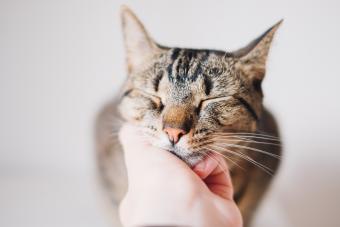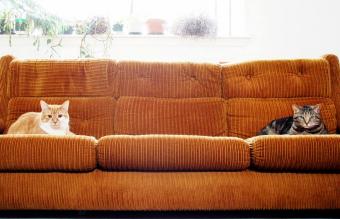
After pet parents establish a bond with their feline friend, they quickly figure out the best areas to scratch and how to pet a cat. Most cats tolerate different levels of affection. With that in mind, cat lovers must be able to read their pet's body language. Not every cat wants to be touched.
How to Pet a Cat
If your cat proactively seeks out family members, the best areas to pet are the chin and forehead. Some cats prefer a certain type of petting and may or may not enjoy it when people pick them up.
Do Cats Like to Be Pet?
Every cat is an individual, but their genetics and environment influence some felines. For example, Persian cats rank as the least active across most cat breeds. Your Persian may not tolerate a ton of affection.
Cats Are Individuals
Cats with aloof personalities are still wonderful companions. There may be some days your cat wants to hug, and other days he prefers a cat cave.
Pet parents may enjoy a 'nose-to-nose' touch with a cat they already know. Straighten out your finger and provide a little pressure to the tip of your cat's nose. If your cat feels affectionate, he may push his nose back into your finger.
Some Cat Breeds Are Difficult to Read
A Bengal cat is active, and this breed needs an environment with a scratching post, puzzle toys, and a lot of enrichment activities. This breed is busy, so it is difficult to determine when or if they want affection. You may wait until your Bengal cat approaches you for a head butt.
Tolerance Levels for Physical Affection Varies
Cats are just like humans. Some people enjoy a massage, and others don't want anyone to touch them! Cat owners need to watch their cat's body language. Never assume your new cat is comfortable with the same physical contact you gave another feline.
Read Your Cat's Body Language
If a cat approaches you, the interaction is likely to be longer than if you walk up to your cat. There are many behavioral signs to look for, and a change of mood may indicate something is wrong with your cat.
- Change in activity
- Increase in vocalization
- Change in routine
Observe the Environment
If you recently lost a family member or live in a new home for the first time in years, your cat may react to that change of environment. Perhaps a new cat is now on your lap all day, and your old cat boycotts affection because he's jealous.
Age, Pain, or Illness Are Factors
Pet parents need to be vigilant with vet appointments to rule out a medical condition. Your cat may be in pain from dental disease or arthritis. If physical affection and belly rubs are an evening ritual, and now they hide every evening, schedule a vet appointment.
Where Do Cats Like to Be Pet?
You may enjoy a head butt from your cat. A head butt is always a sign of cat love and a massive display of affection. With that in mind, there are universal places to pet a cat, but they need to trust you.
- Cheeks
- Chin
- Forehead
- Tail
Some Cats May Enjoy Hugs
Pet parents must read the body language of their companion animal. Observe your cat and possibly see your vet to rule out a medical condition if his behavior suddenly changes. Some cats tolerate different levels of affection. Let your cat approach you when he wants to be petted rather than chase him around the house. If you live with a new cat, there is a period where you both need to learn to trust one another. Your feline buddy may only be interested in a weekly cuddle session or may enjoy physical affection every evening.







